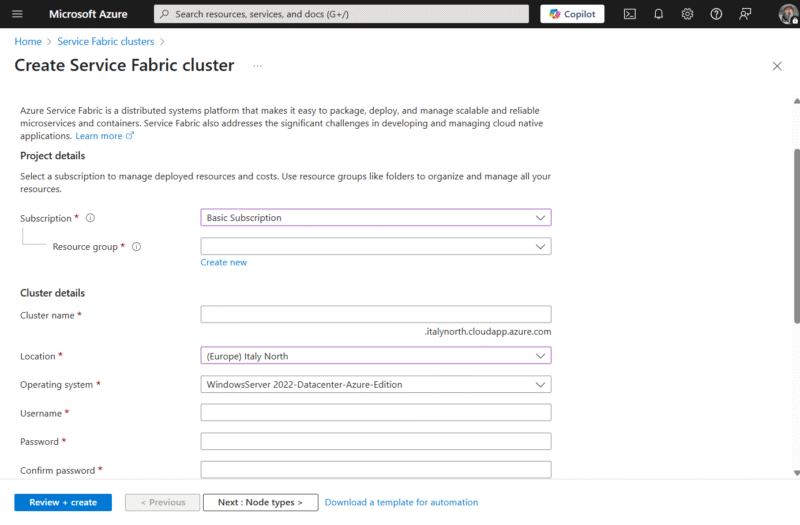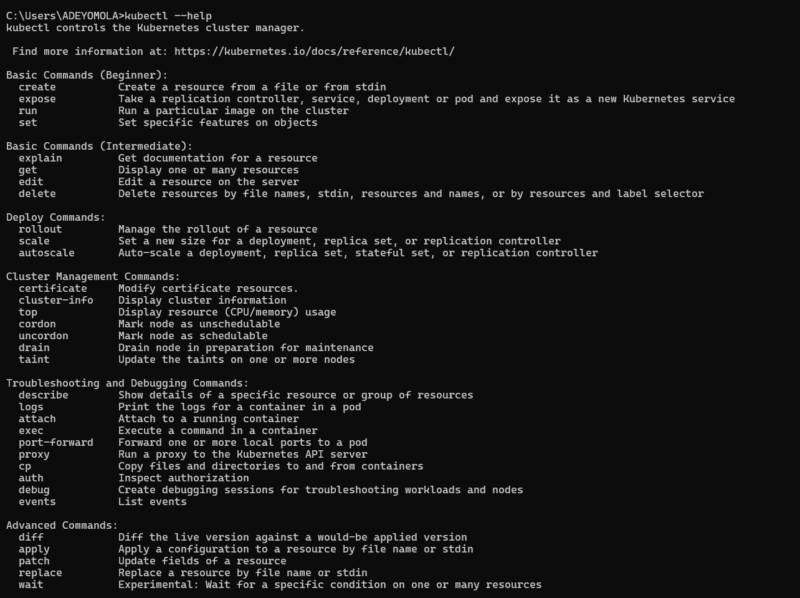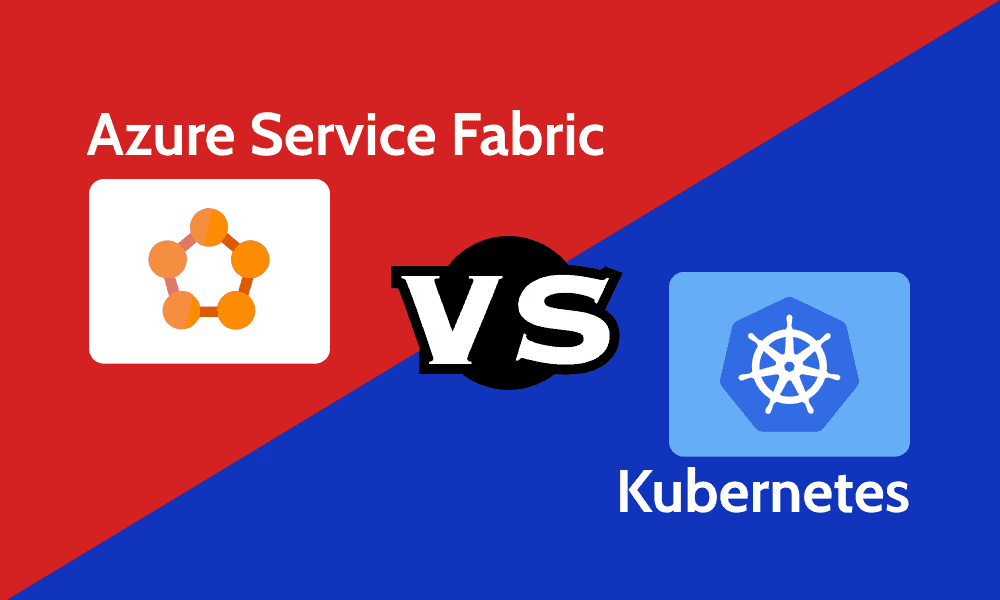Azure Service Fabric and Kubernetes are among the popular options for container orchestration and life cycle management in microservices architecture in cloud computing. Azure Service Fabric offers a higher level of abstraction compared to Kubernetes, so it’s much easier to start using. Meanwhile, Kubernetes offers a higher level of customization.
Even though they generally serve the same purpose and have similar capabilities, their setup and operations are quite different. This guide compares Azure Service Fabric and Kubernetes, digging into their differences as well as the pros and cons.
Azure Service Fabric vs Kubernetes at a Glance
Azure Service Fabric and Kubernetes orchestrate containers, scale resources and support statefulness. However, the extent of their state management, monitoring and abstraction sets them apart. The table below highlights these differences and some similarities.
| Feature: | Azure Service Fabric | Kubernetes |
|---|---|---|
| Statefulness | Has various built-in features for state support, including automatic state backup and restore. | While it supports statefulness using StatefulSets and Persistent Volumes, it requires third-party tools for automatic state backup and restore. |
| Scaling | Scales horizontally at service, application, partition and node levels. Can also scale vertically if the cluster is healthy. | Can scale horizontally at pod and node levels. Can also scale vertically using resize policies. |
| Support | Smaller community of users, so support is primarily from the Microsoft Azure team. | Has a larger ecosystem, so you can find support on various public platforms. |
| Application model | Supported application models include containers, reliable actors, reliable services and guest executables. | Works with any application that can be containerized. |
| Focus | Managing and deploying stateful applications in microservices using programming models. | Automating the deployment and management of the life cycle of containerized applications. |
| Monitoring & diagnostics | Offers three layers of monitoring: application, cluster and infrastructure monitoring through its integration with Azure Monitor and Application Insights. | Examines pods, containers, services and clusters. It offers two APIs for examining resources: a resource metrics pipeline and a more detailed full metrics pipeline. |
| Abstraction | More abstraction, making configuration less demanding. | Less abstraction, requiring more effort to set up. Managed Kubernetes services reduce the burden of configuration. |
| Portability | Service Fabric is cloud agnostic, so you can use it on non-Azure public clouds and on-premises. However, its management and integration with other tools is more seamless on Azure. | Kubernetes is also cloud agnostic but with a fairly uniform experience across different cloud platforms. |
What Is Azure Service Fabric?
Azure Service Fabric is a platform that streamlines the packaging, deployment and management of applications in microservices architecture on distributed systems. It is used for container orchestration, state management in microservices and application life cycle management.

A Service Fabric cluster offers less abstraction than a Service Fabric managed cluster.
Although it is an Azure product, Azure Service Fabric is somewhat cloud agnostic. It is compatible with Windows and Linux operating systems, and you can use it with all major cloud providers and on-premises. Although it deals with containerized applications, it also allows you to deploy existing applications as guest executables.
Azure Service Fabric Pros
The pros of Azure Service Fabric center on its abstraction and deep integration with Microsoft technology:
- Azure Service Fabric offers various programming models, including Reliable Services and Reliable Actors. These models come with built-in configurations — such as health checks and version control — reducing how much configuration you have to complete to get it up and running.
- Service Fabric comes with feature-rich built-in state management, which not only ensures statefulness but also enhances availability by replicating state across multiple nodes. Furthermore, Service Fabric addresses the need for extra redundancy through automatic state backup and restore.
- As expected of an Azure product, Azure Service Fabric integrates deeply with .NET applications and Windows Server. Therefore, if you have a .NET application built in an environment with various Windows tools, migration to Azure Service Fabric will be relatively seamless.
- Many other Azure services — including Microsoft Power BI, Dynamic 365 and Azure SQL Database — run on Azure Service Fabric, highlighting its reliability.
- Although it is deeply integrated with Microsoft services, Azure Service Fabric can run on other public clouds and on-premises.
Azure Service Fabric Cons
Despite being helpful, Azure Service Fabric’s abstraction, programming models and Microsoft integration can be limiting.
- Even though Azure Service Fabric is usable across public cloud platforms, its operation on non-Azure platforms isn’t consistent with what you’ll experience in Azure.
- Due to its high level of abstraction (especially Service Fabric managed clusters), you have less control over the underlying infrastructure compared to Kubernetes.
- In addition to limiting control over networking and infrastructure, Azure Service Fabric’s abstraction is sometimes an obstacle when trying to diagnose and resolve issues.
- Azure Service Fabric isn’t quite as popular as Kubernetes. For this reason, it has a smaller ecosystem, fewer experts, less support and fewer third-party integrations.
What’s Kubernetes?
Kubernetes is an open-source container orchestration tool. It is used to automate container deployment and scaling in a distributed cluster of servers. It also manages containerized application life cycles, facilitating processes such as self-healing, service discovery and batch execution. (See how it compares to the open-source containerized system Docker in our Kubernetes vs Docker guide.)

Kubernetes is typically accessed from a command-line interface using Kubectl.
Kubernetes supports Windows and Linux and is cloud agnostic, so you can use it on any public cloud platform. In fact, many public cloud platforms offer managed Kubernetes platforms, which are alternatives for when you want to abstract a configuration.
Kubernetes Pros
Kubernetes’ customizability, minimal abstraction and open-source nature are crucial to its pros, as discussed below.
- Kubernetes is highly extensible, as it allows you to create custom resource definitions (CRDs) to match your specific application or infrastructure needs. This makes it highly adaptable to a vast range of workloads.
- Thanks to its relatively low level of abstraction, Kubernetes allows extensive control over configuration, including networking and security.
- With Kubernetes, you can scale vertically (resize policies) and horizontally (horizontal pod autoscaling and node autoscaling).
- Kubernetes automates service discovery, exposing pods to network traffic. At the same time, it ensures balanced traffic distribution to pods in a container runtime interface, ensuring no single pod becomes overwhelmed.
- Kubernetes is self-healing; it monitors the health status of pods and nodes, and tries to restart them when it detects that they are unhealthy. If that fails, it schedules pods to healthy nodes or spins up a new node.
Kubernetes Cons
The downsides of Kubernetes are mostly related to its low level of abstraction and relative shortage of built-in features.
- Kubernetes offers StatefulSets for managing stateful applications, but its base state management doesn’t quite match what Service Fabric offers. For one, Kubernetes doesn’t have a built-in solution for automatic state backup and restore, whereas Service Fabric does.
- Although Kubernetes gives you more control and room for extensive customization, this also means you have to do more work to set your cluster up, especially when you’re not using a managed Kubernetes solution.
- Kubernetes configurations are declared using YAML files, which can get complex with larger deployments. As YAML files become more convoluted, you’ll have to do more work, and errors are more likely to appear.
Kubernetes vs Azure Service Fabric: Key Differences
The key differences between Kubernetes and Azure Service Fabric include state management, ease of configuration, programming models and monitoring.
- State management: While both support stateful deployments, Azure Service Fabric offers extensive state management, including automatic state backup and restore. With Kubernetes, you need tools like Velero or Kasten K10 for automatic state backup.
- Programming models: Unlike Kubernetes, which has no influence on application code, Azure Service Fabric comes with programming models, which are frameworks that simplify application development in microservices.
- Monitoring: Service Fabric’s monitoring is more robust and offers more granularity than the built-in Kubernetes monitoring system. That said, you can enhance monitoring on Kubernetes with tools like Grafana.
- Application type: Kubernetes supports only containerized applications, but Service Fabric supports both containerized and non-containerized applications.
- Ease of configuration: Since it takes care of most of the infrastructure management, Azure Service Fabric is relatively easier to configure, especially on Azure. Kubernetes generally requires more infrastructure management, so it isn’t as easy to configure.
- Cloud portability: Although Service Fabric and Kubernetes are cloud agnostic, Service Fabric is best used with other Azure services. Kubernetes, on the other hand, runs consistently across different platforms.
- Ecosystem: Azure Service Fabric has a smaller ecosystem, hence its fewer third-party integrations. However, Kubernetes has a large ecosystem and more integrations.
Final Thoughts
Compared to Kubernetes, Azure Service Fabric offers more features out of the box. However, Kubernetes is more flexible, customizable and portable, and it has a broader range of third-party integrations.
You can see how more cloud platforms compare in our cloud computing platform comparison guide.
Would you opt for Kubernetes’ customizability and flexibility over Service Fabric even though it requires more configuration? In your experience, which service has given you better results: managed Kubernetes services or traditional Kubernetes? Leave a comment below with your thoughts. Thank you for reading.
FAQ: Kubernetes vs Azure Service Fabric
-
Azure Service Fabric is a distributed systems service that makes it easy to manage scalable and reliable microservices running stateful applications. Azure Kubernetes Service is a managed Kubernetes service used to manage the life cycle of containerized applications.
-
The Azure equivalent of Kubernetes is Azure Kubernetes Service. However, tools like Azure Container Instances and Azure Service Fabric play a similar role to Kubernetes.
-
Azure Service Fabric is used for managing the life cycle of stateful applications in microservices architecture, playing roles such as state management and container orchestration.









